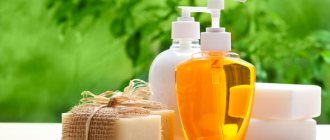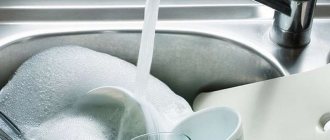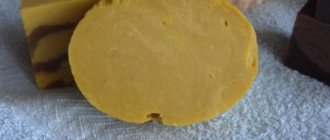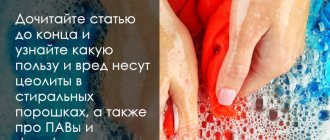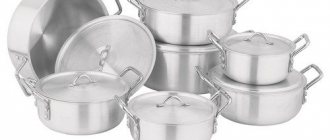105
Hi all. Let's talk about laundry soap. I think that every family has at least a piece of this product. Of course, at the moment, many people use this soap only to wash off something very dirty, for example, hands smeared with fuel oil or to wash a jacket soiled by it.
Brown or gray-yellow bars of laundry soap with an unpleasant odor have today been replaced by modern detergents in bright packaging, with a pronounced fruity, floral aroma. Isn't it in vain?
I think it’s too early to throw away laundry soap, since it not only cleanses dirt, but also heals our body. Over many years of use, our ancestors have proven this and you should not neglect their advice. So the question is: is laundry soap good for use on the body or not? For those interested, read on.
Laundry soap, manufacturing method, composition, types
Soap with a pH value of 11-12, which contains alkalis, fatty acids of plant and animal origin, is called household soap.
Methods for making laundry soap
The French from the province of Provence were the first to produce a healthy natural product based on olive oil in the second half of the 17th century.
In Russia, in the production of hygiene products, the use of animal fats is allowed. Laundry soap is made in two ways.
A simpler one is to obtain soap glue from fat and alkali, after which hardens, bars of low fat content are formed.
In the second option, the glue is treated with a solution of table salt, producing core soap with a high content of fatty acids and soap lye. To make category I laundry soap, the procedure is repeated 2-3 times.
The use of environmentally friendly laundry soap in everyday life - washing, bleaching, washing floors, surfaces, dishes. But this antibacterial product is also included in traditional medicine recipes and eliminates cosmetic flaws.
Ingredients in laundry soap
Laundry soap contains the following ingredients:
- saturated fats – stearic, lauric, palmitic acids;
- unsaturated fatty acids - linoleic, linolenic, oleic;
- vegetable lard;
- rosin;
- petroleum products treated with alkali (asidol, mylonafte);
- caustic and soda ash;
- zinc, titanium white.
Composition of laundry soap
Palmitic and stearic acids in natural laundry soap make the product hard and latherable only in hot water. Unsaturated fats oxidize quickly and create a liquid consistency, but they can be used in cold water.
The composition of household soap includes technical pork, lamb, beef lard, fish oil, and hydrogenated vegetable oils. Salomas, which reduces the cost of production, is an undesirable component, due to which the bars become non-plastic, difficult to lather, and quickly deteriorate.
Rosin is added to extend the shelf life of the product and enhance foaming in cold water. But this component has a significant drawback. Soap with rosin sticks to the skin. Caustic and sodium carbonate are needed for saponification of acids. To give the product a marketable appearance, white is used.
So, the composition of the bar is environmentally friendly, hypoallergenic, fatty acids and sodium salt, nothing extra, no dyes or flavors.
Laundry soap categories
Depending on the percentage of triglycides contained, numbers are squeezed out on the bars, by which the category is determined:
- first - 72;
- second - 70;
- third - 65;
In a product of the first category, the amount of acids is from 70.5%, in the second - 69-70%, in the third - 61-65%. If the detergent contains less fat than the category III standard, numbers are not marked on the bars.
Types of laundry soap production
Laundry soap is produced in the form of:
- liquid solution;
- pieces;
- ointments;
- powder.
Top 5 best
Manufacturers of household chemicals offer soap intended exclusively for washing clothes. The top 5 looks like this:
Eared nanny . Laundry soap can be used to care for baby clothes. Contains stain remover, enzymes and glycerin, but no fragrance. The cost of the bar is 32 rubles.- Sarma antibacterial 3 in 1 . It can be used not only for washing, but also for washing dishes and hands. The cost of the bar is 31 rubles.
- Dr. Beckmann . It is used to remove stubborn stains. It is suitable for white and colored fabrics, for washing carpets and upholstery. The cost of the bar is 120 rubles.
- Stork with glycerin . Fragrance-free bar, suitable for getting rid of stubborn stains. The cost of a package weighing 150 g is 28 rubles.
- DURU Clean&White . It contains enzymes and a stain remover. It can be used to care for white and colored items. The cost of the bar is 84 rubles.
You can purchase any detergent in a retail store, in the household chemicals department, or order it in the online market.
The benefits of laundry soap
What cures
The beneficial properties of laundry soap are hypoallergenic, natural composition, and safe for humans. Thanks to its antiseptic, anti-inflammatory effect, the product:
- treats dandruff, seborrhea;
- heals wounds, burns;
- relieves irritation after insect bites;
- relieves skin diseases, acne, greasy shine;
- disinfects personal hygiene items - combs, toothbrushes;
- soothes the skin after depilation, razor;
- deeply cleanses the skin in a steam room with a broom;
- relieves inflammation.
Where is it applied and used
Almost everywhere, both for skin care, hair care, and for cleaning the apartment. Traditional medicine also did not miss its moment in the use of laundry soap.
It is used for foot fungus, to get rid of cracked heels and corns in baths.
The product reduces the symptoms of varicose veins; it is used for tired leg syndrome, calf cramps, and knee pain.
To get the result, flat pieces (you can also grate them) are placed in socks or applied to a sore spot.
What does it get rid of?
Soap relieves swelling, bruises at the site of bruises, rhinitis during colds, and stops hair loss. Soap foam helps neutralize the effects of sunburn and prevents blisters.
Cosmetologists advise occasionally taking a steam bath with a broom soaked in soap suds. This procedure cleanses the skin well, which begins to glow.
How to choose a good one?
Laundry and baby soap are best suited for washing clothes. Preference should be given to a product without additives whose origin is unknown.
For processing things they do not use:
Handmade soap.- Products with insoluble particles. They can be added to the bar for decoration or to provide a scrub effect.
- Soap with essential oils. They leave stains on things.
- A product with a complex chemical composition. For allergy sufferers, such household chemicals are strictly contraindicated.
The solid form of release has a more natural composition, it contains less dyes, preservatives and fragrances.
Laundry soap in folk medicine
Treatment with laundry soap has long been used by people.
Bites, scratches, burns
If you are bitten by a dog, scratched by a cat, or have a mild burn, immediately wash the injured area with soap.
If you have a burn , then apply a thin layer of soap to the redness and you will not get a blister and the sore spot will heal faster. There is nothing unusual about this, because this soap is a bactericidal agent.
Hemorrhoids or thrush
If you suffer from hemorrhoids or thrush, then use only laundry soap when washing. If you feel a cold or runny nose approaching, then immediately wash your nose with soap or lubricate the wings of the nose from the inside with soapy water.
Runny nose
I can say from personal example that even the most severe runny nose will go away almost the next day, perhaps thanks to the interferons that are present in the composition. The antiviral properties of such a remedy have been proven; there will be no side effects or unpleasant sensations.
Sinusitis
Instead of a puncture, you can get rid of accumulated fluid in the maxillary sinuses using a healing composition.
To prepare it, combine grated soap, onion juice, milk, honey, and any vegetable oil in equal parts (1 tablespoon each).
Place the mixture in a water bath and stir until thickened. Cotton swabs are moistened with the composition and inserted into the nostrils while lying down. wait for the mucus to drain out through the mouth.
The procedure is repeated every other day.
Bedsores
The grated bar of soap is mixed with triple cologne until a creamy consistency is obtained.
The ointment is used to lubricate areas of the skin that experience greater pressure.
Boils, abscesses
To open the ulcers, prepare a composition of grated onions, laundry soap, and granulated sugar.
All ingredients are combined in equal proportions.
The soap-onion mixture is applied to the sore spot overnight and secured with a bandage.
Foot fungus
Every morning and evening for a week, wash your feet with a hygienic product with cool water using a brush.
After drying with a towel, the affected areas are lubricated with iodine.
If you go to a public shower, sauna or swimming pool, wash your feet with laundry soap first.
Varicose veins
For varicose veins, to eliminate swelling, pain, and to relax blood vessels, make a tincture of 10 aspirin tablets and 200 ml of vodka.
After two days, add a large spoonful of grated soap to the liquid. A gauze napkin is moistened with the composition and placed on the leg.
The compress is kept for a couple of hours.
An ointment prepared from 100 g of lard twisted in a meat grinder, a similar amount of ground millet, and crushed laundry soap is effective for varicose veins.
If the mass turns out to be thick, it is diluted with vegetable oil.
The veins are lubricated with a medicinal agent and the legs are bandaged.
Medicinal properties
The alkali content in laundry soap means it has an antibacterial effect. In medicine, laundry soap is used as an antiseptic. In addition, laundry soap is an absolutely harmless product made from environmentally friendly raw materials. The healing properties of soap help in the prevention of various diseases.
Applicable for:
- risk of infection from a patient with an infectious disease;
- In wounds, scratches, cuts, soap speeds up the healing process:
- dog bite;
- bruise, relieves swelling and bruising;
- runny nose, treat the sinuses with soapy water;
- abscesses, disinfection from pus;
- fungal diseases of the feet;
- household burns;
- irritation after shaving;
- thrush and other gynecological fungal diseases;
- washing your hair (helps get rid of dandruff);
- acne and pimples;
- corns and cracks on the feet;
- constipation;
- sprained ankle joints.
Tar soap - beauty and health
To treat and prevent diseases using laundry soap, prepare either a soap solution or baths, or cut out pieces of soap shaped like “candles.” For example, for a runny nose, it is recommended to soak cotton swabs in a solution of laundry soap and anoint the inside of the nasal passages. For cuts or inflammations on the skin, you just need to wash the wound with soap and leave it to dry until a thick crust forms, and only then rinse it off with warm water. Calluses, corns and cracks on the feet can be cured by regular use of a bath with laundry soap. The recipe for such a bath is quite simple: you need to grate a bar of soap, hot water and one teaspoon of soda. The bath is suitable for daily use for 20–30 minutes.
Boric soap - a magical hygiene and cosmetic product
In addition, laundry soap is also suitable for intimate hygiene. With its help it is very easy to get rid of such unpleasant diseases as thrush, prickly heat, constipation. This product has no contraindications for use, that is, it can be used by older people and women who are pregnant.
Laundry soap for washing hair
You can also wash your hair with this product; it will make your hair thicker and get rid of dandruff and other hair problems.
I can say from personal experience that it really works, the first time you wash your hair with shampoo, preferably baby shampoo, and the second time with soap. You do not need to rub with the bar itself, but only with the foam that you applied to your hands.
You don’t need a lot of foam, otherwise you won’t be able to rinse your hair completely. Massage your scalp and rinse, then wash with shampoo again and rinse with water with vinegar or citric acid.
Don't worry, vinegar won't cause any harm as long as it is added to water within reasonable limits. On the contrary, after such a “rinse”, your hair will shine.
Other Supplements
Rosin is found in low grade soap. This ingredient promotes good foaming properties and dissolution at low temperatures. Moreover, thanks to this component, the shelf life of the detergent increases several times, preventing it from going rancid.
Salomas, which is used in the production of margarine or spreads, can also be added to the composition of brown bars.
Soap stocks are formed when fats and oils are purified with special alkali solutions. If the soap stocks are of high quality, then thanks to them the bar of soap becomes hard. And if they have not undergone an insufficient degree of purification, the soap turns out to be a very dark color with a characteristic and very unpleasant odor.
Inorganic components
Inorganic ingredients such as soda ash or caustic soda are used to saponify fats.
Sodium silicate helps remove stickiness from soap after adding rosin.
Laundry soap for use in vegetable gardens and gardens
Laundry soap is an excellent disinfectant that can be used to wash any container before sowing seeds and planting plants in pots or containers.
Laundry soap has long been used by our gardeners to combat pests and fungal plant diseases, for example, gray mold (Botrytis cinerea).
This disease is typical for strawberries, onions, cabbage, grapes, peppers, cherries, plums and many other crops. First, a light fluffy grayish coating appears on the plant, then it grows, leaves, flowers and fruits lose their elasticity, rot and die.
To save your plantings from this scourge, prepare a solution of laundry soap at the rate of 10 g per 1 liter of water, and to enhance the effect, add garlic or tansy extract to it. Spray the plants with it once every 10-14 days, no more than 3 times in a row.
A solution of laundry soap has an alkaline reaction, forms a film on the surface and successfully copes with insects that do not have chitinous cover - aphids, Colorado potato beetle larvae, spider mites.
Grate 150g of laundry soap 75% into 5 liters of hot water on a coarse grater, mix well, let stand until the soap disperses, stirring the resulting solution from time to time to create a stiff foam.
Then spray the plants or trees. When spraying, a soap solution with foam covers the infected surface, so that there is not enough air for the insects and they die. After three or four days, see if there are any insects left; if there are, then try to spray again. After a week, you can wash all the plants yourself or wait for rain!
Types and scope of application
A modern manufacturer presents laundry soap of different consistencies. It can be found in the form of bars, liquid and even powder.
I would like to pay special attention to liquid laundry soap. The low price and ease of use have allowed this product to become very popular among housewives.
However, contrary to the manufacturers’ statements about the identity of its composition with solid species, this is not entirely true.
Note!
The specifics of production and the components of real laundry soap do not allow this product to be produced in liquid form!
Pay attention to the composition of such a detergent, and you will be convinced that apart from the name with a solid analogue, they have nothing.
The basic components of liquid laundry soap are various surfactants, usually toxic. Indeed, it does an excellent job of removing various kinds of dirt on fabrics and grease on dishes, but it is far from an environmentally friendly product. Using it, you are not immune from the occurrence of an allergic reaction, as after using any other synthetic detergent. And, of course, you shouldn’t wash children’s clothes with such “laundry” soap.
What harm does laundry soap cause to human skin?
Despite the antimicrobial, cleansing properties of the hygiene product, regularly .
Frequently washing your body with laundry soap leads to sad consequences. Laundry soap dries the skin, weakens the barrier properties of the protective layer, corroding it with alkaline components, disrupting the acid-base balance.
The epidermis becomes thinner and becomes vulnerable to mechanical damage due to temperature changes and burns when exposed to ultraviolet radiation.
If you wash a child with laundry soap, his or her incompletely formed local immunity will be weakened. Infection can penetrate through the delicate baby skin.
Women who use this product for a long time look older than their age due to the formation of early wrinkles, redness, irritation, and dehydration of the skin. A feeling of tightness and microcracks appears.
Scientific research has proven that, contrary to the belief that soap cures thrush, the product is not suitable for washing. The detergent temporarily suppresses the symptoms, but will not cure the disease.
Pharmacy products effectively combat candidiasis. Hygienic procedures for the intimate area are performed using specially designed products.
Laundry soap dries out the mucous membrane, disrupts the microflora, and kills lactic acid bacteria.
Production Features
To understand the secret to the long-term success of this simple detergent, you need to understand how laundry soap is made.
The soap making process involves boiling the detergent and forming bars for sale.
Soap is prepared using two methods:
- Direct production;
- Indirect method.
The direct method of soap production consists of processing all the original ingredients into a special soap glue. During cooking, soda is added to it. The glue is left to harden, and then cut into pieces and sent to store shelves. Such brown bars contain 40-70% fatty acids. The direct method allows you to obtain soap with high cleaning qualities and low fat content.
Video: how soap is made:
During indirect production, laundry soap is prepared by treating the resulting soap glue with a salt solution, the so-called salting out. As a result, 2 components are obtained: a soap core and a soap piece (lye). Soap made this way has slightly more fatty acids than bars made with glue.
In order for the detergent to acquire high-quality properties, it must be re-treated with a saline solution.
What cosmetologists do not recommend
In order not to cause harm to the body, cosmetologists do not advise :
- frequently use laundry soap on the body to remove the fatty protective layer along with the dirt;
- leave foam on mucous membranes;
- wash your face more than twice a week;
- use the product for household purposes without gloves to protect the skin of your hands from peeling and loss of elasticity.
Attention! For problem skin, wash only oily areas with a solution of laundry soap, since in addition to dryness, you can get chemical burns that turn into dermatitis.
After completing hygiene procedures, apply a moisturizer. If foam gets into the eyes, rinse the mucous membrane thoroughly. Soap is contraindicated in case of individual intolerance, thin, sensitive and dry skin.
Laundry soap, like other products, has both benefits and harm. You just need to follow the rules of use and everything will be fine!
Can it be added to an automatic washing machine?
Soap can be added to the washing machine, but in order not to harm household appliances, you need to adhere to the following recommendations:
- Preference is given to liquid soap.
- Be sure to take tissue type into account to adjust the dose. For example, wool contributes to the formation of abundant foam. Therefore, such products will require less detergent.
- To prevent fatty acid salts from settling on machine parts, you should not wash things with soap too often.
- After completing the cycle, it is recommended to rinse the drum with vinegar water.
The detergent composition for the washing machine can be prepared from a bar. It is grated and dissolved with hot water until a homogeneous mass is formed. The resulting composition is poured into the liquid powder compartment.
Procedure for hand washing with soap
The procedure for washing with soap is practically no different from washing with washing powder:
- prepare a soap solution;
- group things by color, type of fabric and degree of soiling;
- It is better to soak too dirty items before washing;
- Items made from fading or delicate fabrics are best washed with soap and cool water;
- during washing, you need to separately rub the contaminated areas, collars and cuffs on shirts;
- After washing with soap, items should be rinsed several times until there are no traces of soap solution left in the water.
Effect on clothing and water
Using laundry soap for laundry has both positive and negative sides. On the one hand, there is complete confidence in the composition, I am pleased with the financial accessibility, as well as the result. But on the other hand, when using soap, the washing machine may suffer, because a coating remains on its walls, which eventually settles on the working parts, they become clogged and a breakdown occurs, followed by expensive repairs. Also, natural laundry soap can harm the fabrics from which clothes are made, especially delicate ones.
You can reduce the negative impact of laundry soap on clothes and cars by following simple rules:
- No more than 30 grams of soap should be consumed per 10 liters of water;
- The maximum washing water should be 70 degrees, and it is better not to raise it above forty.
The type of water is also of great importance. If it is hard, then approximately 30% of the total amount of soap will be used to soften it. But you can further soften it with soda.
There is a simple way to find out if your water is hard. To do this, you just need to lather the soap under running water. The harder it is, the worse it will lather.
Which soap is best for hand washing?
For hand washing children's clothes, it is better to use baby soap without additives. To wash other types of clothes and linen, it is better to use laundry soap. For greater convenience, it is better to grate the laundry soap, then dissolve the soap shavings in water. The soap solution does not irritate or dry out the skin of the hands, and at the same time efficiently washes almost all common types of dirt. Chistown washing powders, made from crushed natural soap, have similar properties.
How to prepare liquid laundry soap
The most effective and simplest way to prepare liquid soap for a washing machine:
- Grate 100 g of soap.
- Pour the finished shavings into a metal container (it’s better if it’s an unnecessary pan), pour hot water (1 l).
- Place on low heat. Stirring frequently until completely dissolved. Do not let the mixture boil.
- In a second container, dilute four tablespoons of baking soda. Add the finished mixture to the soap mass.
- Mix thoroughly until smooth and allow the liquid to cool.
Using these tips, you can not only prolong and make the life of your home help easier, but also save yourself and your family from the aggressive components of washing powders.
Weaknesses and strengths
Soap has a wide range of uses. It is often used as a dishwashing detergent or hand wash. Its main advantage is its disinfectant and antiallergic properties. It also perfectly removes stains of organic origin and is very economical to use. The disadvantage is that soap cannot remove inorganic contamination.
Grated baby soap
What types of clothes are best washed with soap?
You can wash almost any item with soap. It is not recommended to wash with soap:
- woolen items;
- heavily soiled items requiring deep cleaning and disinfection.
It is better to wash with soap:
- children's things, especially things for newborns, because soap does not dry out or irritate children's skin; clothes of newborn children are washed only with baby soap or special baby powders based on natural soap like Chistown Children without phosphates and other chemicals;
- things of people prone to allergies; sometimes replacing washing powder with soap or soap powder when washing completely relieves people of allergies;
- It is better to wash lace underwear, handmade items, made from delicate fabrics, with various inserts by hand in a warm solution of natural soap.
